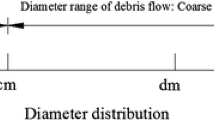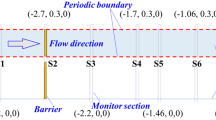Abstract
To reproduce a subaqueous debris flow with a friction coefficient of approximately tan1° in field, material with a huge volume may be involved. In this research, a steady subaqueous debris flow with a friction coefficient of approximately tan1° was produced by using the rotating flume experiment apparatus (Debris Flow Maker, DFM) with only 40 g of silicon powder. Subsequently, the mechanism of the low friction coefficient was interpreted with the hypothesis of dense agglomeration hitting (DAH). DAH means hitting of the dense agglomeration of dense flow on the flume's bottom plane. The following issues on DAH are considered: (I) the high velocity of the flume's bottom plane induces a strong hitting of particles; (II) the hitting elevates the liquid pressure near the boundary between the agglomeration and the flume's bottom plane; (III) the energy loss due to collision inside the particle agglomeration is limited. The experimental results provide an alternative method of producing subaqueous debris flow and an alternative measurement method of its friction coefficient; the hypothesis provides an alternative interpretation on the mechanism of low friction coefficient of subaqueous debris flow.











Similar content being viewed by others
References
American Society for Testing and Materials (ASTM) (2002) Standard test methods for coefficient of static friction of uncoated writing and printing paper by use of the inclined plane method. ASTM D-4918-97 (2002)
Bagnold RA (1954) Experiments on a gravity-free dispersion of large solid spheres in a Newtonian fluid under shear. Proc R Soc Lond a 225:49–63
Baumann G, Janosi IM, Wolf DE (1995) Surface properties and the flow of granular material in a two-dimensional rotating-drum model. Phys rev E51:1879
Bryn P, Berg K, Forsberg CF, Solheim A, Kvalstad TJ (2005) Explaining the Storegga slide. Mar pet Geol 22:11–19
Bull S, Cartwright J, Huuse M (2009) A review of kinematic indicators from masstransport complexes using 3D seismic data. Mar pet Geol 26:1132–1151
Chou S, Hsiau S (2012) Dynamic properties of immersed granular matter in different flow regimes in a rotating drum. Powder Technol 226:99–106
Cox R, Mason S (1971) Suspended particles in fluid flow through tubes. Annu rev Fluid Mech 3:291–316
Cruden DM, Hungr O (1986) The debris of the frank slide and theories of rockslide-avalanche mobility. Can J Earth Sci 23:425–432
De Blasio FV, Engvik L, Harbitz CB, Elverhøi A (2004) Hydroplaning and submarine debris flows. J Geophys res 109:C01002
De Blasio FV, Elverhøi A, Engvik LE, Issler D, Gauer P, Harbitz C (2006) Understanding the high mobility of subaqueous debris flows. Nor J Geol 86:275–284
Deng JL, Yu B, Shen SL (2016) A study on the effects of flow rate on the friction slope of debris flow by rotating flume tests. J Eng Geol 24:976–980 (in Chinese)
Despeyroux A, Ambari A (2012) The drainage of non-Newtonian fluids in the quasi-steady motion of a sphere towards a plane. Microfluid Nanofluid 12:639–648
Dugan B, Flemings PB (2000) Overpressure and fluid flow in the New Jersey continental slope: implications for slope failure and cold seeps. Science 289:288–291
Elverhøi A, De Blasio FV, Butt FA, Issler D, Harbitz C, Engvik L, Solheim A, Marr J (2002) Submarine mass-wasting on glacially-influenced continental slopes: processes and dynamics. In: Dowdeswell JA, Cofaigh CO (eds) Glacier-influenced sedimentation on high-latitude continental margins. Geological Society of London Special Publication no. 203. The Geological Society of London, London, p 73–87
Elverhøi A, Breien H, De Blasio FV, Harbitz CB, Pagliardi M (2010) Submarine landslides and the importance of the initial sediment composition for run-out length and final deposit. Ocean Dynamics Special Issue 60:1027–1046
Gee MJR, Masson DG, Watts AB, Allen PA (1999) The Saharan debris flow: an insight into the mechanics of long runout submarine debris flows. Sedimentology 46:317–335
Hampton MA (1972) The role of subaqueous debris flow in generating turbidity currents. J Sediment res 42:775–793
Hampton MA, Lee HJ, Locat J (1996) Submarine landslides. Rev Geophys 34:33–59
Hance JJ (2003) Development of a database and assessment of seafloor slope stability based on published literature. The University of Texas, Austin
Harada S, Tanaka T, Tsuji Y (2000) Fluid force acting on a falling particle toward a plane wall. Proceedings of ASME FEDSM'00. ASME 2000 Fluids Engineering Division Summer Meeting. June 11–15, 2000, Boston, Massachusetts. FEDSM2000–11267
Harbitz CB, Parker G, Elverhøi A, Marr JG, Mohrig D, Harff P (2003) Hydroplaning of subaqueous debris flows and glide blocks: analytical solutions and discussion. J Geophys res 108(B7):2349
Heim A (1932) Bergsturz und Menschenleben. Fretz und Wasmuth, Zurich, 218pp. (in German)
Henrich R, Hanebuth TJJ, Krastel S, Neubert N, Wynn RB (2008) Architecture and sediment dynamics of the Mauritania slide complex. Mar pet Geol 25:17–33
Hsu S-K, Kuo J, Lo C-L, Tsai C-H, Doo W-B, Ku C-Y, Sibuet J-C (2008) Turbidity currents, submarine landslides and the 2006 Pingtung earthquake off SW Taiwan. Terrestrial Atmospheric and Oceanic Sciences 19:767–772
Hu W, Xu Q, Rui C, Huang RQ, van Asch TWJ, Zhu X, Xu QQ (2015) An instrumented flume to investigate the initiation mechanism of the post-earthquake huge debris flow in the southwest of China. Bull Eng Geol Environ 74:393–404
Huizinga RJ (1996) Verification of vertically rotating flume using non-Newtonian fluids. J Hydraul Eng 122:456–459
Ilstad T, Blasio FVD, Elverhøi A, Harbitz CB, Engvik L, Longva O, Marr JG (2004) On the frontal dynamics and morphology of submarine debris flows. Mar Geol 213:481–497
Iverson R (1997) The physics of debris flows. Rev Geophys 35:245–296
Kaitna R, Rickenmann D, Schatzmann M (2007) Experimental study on rheologic behaviour of debris flow material. Acta Geotech 2:71–85
Kayen RE, Lee HJ (1991) Pleistocene slope instability of gas hydrate-laden sediment on the Beaufort Sea margin. Mar Geotechnol 10:125–142
Kuenen PHH, Migliorini CI (1950) Turbidity currents as a cause of graded bedding. The Journal of Geology 58:91–107
Larcher M, Fraccarollo L, Armanini A, Capart H (2007) Set of measurement data from flume experiments on steady uniform debris flows. J Hydraul res 45(Suppl.1):59–71
Leonardi A, Cabrera M, Wittel KF, Kaitna K, Mendoza M, Wu W, Herrmann HJ (2015) Granular-front formation in free-surface flow of concentrated suspensions. Phys rev E92(052204):1–13
Liao CC, Hsiau SS, Nien HC (2014) Density-driven spontaneous streak segregation patterns in a thin rotating drum. Phys rev E89:062204
Locat J, Lee HJ (2000) Submarine landslides: advances and challenges. Can Geotech J 39:193–212
Martinez JF, Cartwright J, James D (2006) Frontally confined versus frontally emergent submarine landslides: a 3D seismic characterisation. Mar pet Geol 23:585–604
Masson DG, Harbitz CB, Wynn RB, Pedersen G, Lovholt F (2006) Submarine landslides: processes, triggers and hazard prediction. Philos Trans R Soc a Math Phys Eng Sci 364:2009–2039
Mazzanti P, De Blasio FV (2011) The dynamics of coastal landslides: insights from laboratory experiments and theoretical analyses. Bull Eng Geol Environ 70:411–422
McAdoo BG, Pratson LF, Orange DL (2000) Submarine landslide geomorphology, US continental slope. Mar Geol 169:103–136
Minisini D, Trincardi F, Asioli A, Canu M, Foglini F (2007) Morphologic variability of exposed mass-transport deposits on the eastern slope of Gela Basin (Sicily channel). Basin res 19:217–240
Mohrig D, Whipple KX, Hondzo M, Ellis C, Parker G (1998) Hydroplaning of subaqueous debris flow. Geol Soc am Bull 110:387–394
Mohrig D, Elverhøi A, Parker G (1999) Experiments on the relative mobility of muddy subaqueous and subaerial debris flows, and their capacity to remobilize antecedent deposits. Mar Geol 154:117–129
Moscardelli L, Wood L, Mann P (2006) Mass-transport complexes and associated processes in the offshore area of Trinidad and Venezuela. AAPG Bull 90:1059–1088
Mosher DC, Monahan PA, Barrie JV, Courtney RC (2004) Submarine failures in the strait of Georgia, British Columbia: landslide of the 1946 Vancouver Island earthquake. J Coast res 20:277–291
Mulder T, Alexander J (2001) The physical character of subaqueous sedimentary density flows and their deposits. Sedimentology 48:269–299
Nadim F (2006) Challenges to geo-scientists in risk assessment for sub-marine slides. Nor J Geol 86:351–362
Norem H, Locat J, Schieldrop B (1990) An approach to the physics and the modelling of submarine flowslides. Mar Geotechnol 9:93–111
Piper DJW, Farre JA, Shor A (1985) Late quaternary slumps and debris flows on the Scotian slope. Geol Soc am Bull 96:1508–1517
Posamentier HW (2003) Depositional elements associated with a basin floor channel–levee system: case study from the Gulf of Mexico. Mar pet Geol 20:677–690
Prior DB, Bornhold BD, Johns MW (1984) Depositional characteristics of a submarine debris flow. J Geol 92:707–727
Sanchez M, Levacher D (2008) Erosion of a mud from the Loire estuary by a flow. Bull Eng Geol Environ 67:597–605
Takahashi T (2009) A review of Japanese debris flow research. International Journal of Erosion Control Engineering 2(1):1–14
Tinterri R, Drago M, Consonni A, Davoli G, Mutti E (2003) Modelling subaqueous bipartite sediment gravity flows on the basis of outcrop constraints: first results. Mar pet Geol 20:911–933
Xie T, Wei FQ, Yang HJ, Gardner JS, Xie XP, Dai ZQ, Jiang Z (2016) Calculation of the separation grid design length in a new water-sediment separation structure for debris flow defense. Bull Eng Geol Environ 75:101–108
Yamane K, Nakagawa M, Altobelli SA, Tanaka T, Tsuji Y (1998) Steady particulate flows in a horizontal rotating cylinder. Phys Fluids 10:1419–1427
Zakeri A, Høeg K, Nadim F (2008) Submarine debris flow impact on pipelines—part I: experimental investigation. Coast Eng 55:1209
Acknowledgements
The research work described herein was funded by the National Basic Research Program of China (973 Program: 2015CB057806) and the Key Project of the National Natural Science Foundation of China (No. 41630633). This research was also supported by Specialized Research Fund for the Doctoral Program of Higher Education of China (No. 20120073120020). These financial supports are gratefully acknowledged. Constructive suggestions were proposed by Prof. Bin YU in Chengdu University of Technology, China.
Author information
Authors and Affiliations
Corresponding author
Rights and permissions
About this article
Cite this article
Deng, J., Zhang, X., Shen, S. et al. Low friction coefficient (approximately tan1°) of subaqueous debris flow in rotating flume tests and its mechanism. Bull Eng Geol Environ 77, 931–939 (2018). https://doi.org/10.1007/s10064-017-1081-9
Received:
Accepted:
Published:
Issue Date:
DOI: https://doi.org/10.1007/s10064-017-1081-9




